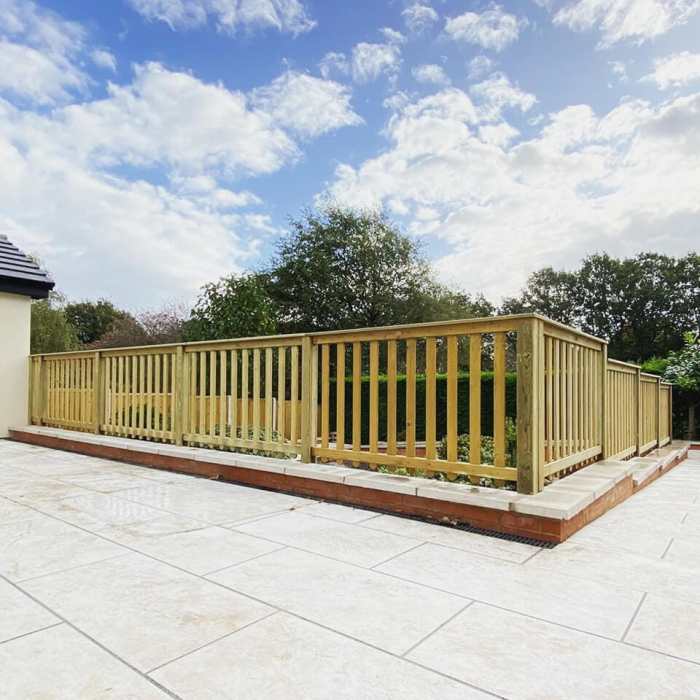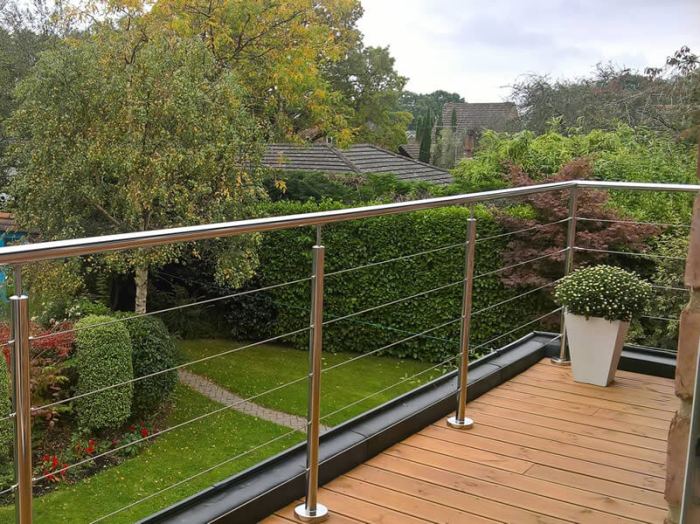Garden balustrade ideas offer a captivating fusion of aesthetics and functionality, transforming outdoor spaces into havens of beauty and safety. Embark on a journey of discovery as we delve into the intricacies of balustrade design, exploring materials, styles, and installation techniques.
From classic Victorian elegance to contemporary masterpieces, balustrades elevate garden landscapes, defining boundaries, creating focal points, and adding vertical interest.
Design Inspiration
Garden balustrades, with their intricate designs and graceful lines, have been a mainstay in architectural landscapes for centuries. They add an air of sophistication and elegance to any garden, framing pathways, terraces, and other outdoor spaces.
From classic designs rooted in architectural history to contemporary interpretations that push the boundaries of traditional styles, there is a wide range of balustrade designs to choose from. Let’s explore some inspiring examples.
Classical Designs
Classical balustrades draw inspiration from ancient Greek and Roman architecture, featuring clean lines, symmetrical proportions, and intricate details. Some notable examples include:
- Doric Balustrade:Characterized by simple, unadorned columns with a plain frieze and a square abacus.
- Ionic Balustrade:Features slender columns with volutes (scrolls) on the capitals and a more elaborate frieze.
- Corinthian Balustrade:The most ornate of the classical orders, with fluted columns and capitals decorated with acanthus leaves.
Contemporary Designs
Contemporary balustrade designs often break away from traditional forms, embracing innovative materials, bold shapes, and unique patterns. Some examples include:
- Stainless Steel Balustrade:Sleek and modern, stainless steel balustrades offer durability and a minimalist aesthetic.
- Glass Balustrade:Transparent or tinted glass panels create a sense of openness and allow light to pass through, enhancing the visual appeal of the garden.
- Corten Steel Balustrade:Weather-resistant corten steel develops a unique patina over time, adding a rustic and industrial touch to the garden.
Material Considerations

The choice of material for a balustrade can significantly impact its durability, aesthetics, and maintenance requirements.
Common materials include stone, metal, wood, and composite, each with unique advantages and drawbacks.
Stone Balustrades
- Pros:Durable, elegant, timeless, weather-resistant
- Cons:Heavy, expensive, difficult to repair
Metal Balustrades
- Pros:Strong, versatile, customizable, low-maintenance
- Cons:Can rust or corrode, may require painting
Wood Balustrades
- Pros:Warm, natural aesthetic, customizable, relatively inexpensive
- Cons:Requires regular maintenance, susceptible to rot and decay
Composite Balustrades
- Pros:Durable, low-maintenance, moisture-resistant, customizable
- Cons:May not have the same aesthetic appeal as natural materials
Height and Spacing
The height and spacing of balustrades are crucial for safety and aesthetics. The optimal dimensions vary based on the location and purpose of the balustrade.
Height
Balustrade height is primarily determined by safety considerations. For residential applications, a height of 36-42 inches is typically recommended to prevent falls. Commercial balustrades may require higher heights, such as 42-48 inches, to comply with building codes.
Spacing
Balustrade spacing refers to the distance between individual balusters. It impacts both safety and aesthetics. A spacing of 4-6 inches is recommended for safety, as it prevents objects or limbs from passing through the gaps. Wider spacing can enhance the visual appeal but may compromise safety.
Styles and Patterns
Balustrades come in a wide range of styles and patterns, allowing you to customize your garden design. Victorian balustrades feature intricate detailing and ornate spindles, while Georgian balustrades are more understated with simple lines and square balusters. Art Deco balustrades are characterized by geometric patterns and bold colors.
Customizing Balustrades
In addition to choosing a style, you can also customize your balustrade with decorative elements and patterns. Consider adding a cap rail or finials to the top of the balustrade for a more finished look. You can also add decorative panels or carvings to the balusters or newel posts.
Installation Techniques
Installing garden balustrades involves various methods, each with its own advantages and considerations. Proper installation techniques are crucial for ensuring the safety and longevity of the structure.
The choice of installation method depends on factors such as the material, design, and location of the balustrade.
Post-Mounted
Post-mounted balustrades are the most common type of installation. They involve setting posts into the ground and attaching the balustrade panels to the posts.
- Suitable for most materials, including wood, metal, and stone.
- Provides a sturdy and stable structure.
- Requires careful planning and excavation for post placement.
Wall-Mounted
Wall-mounted balustrades are attached directly to a wall or other vertical surface.
- Ideal for balconies, terraces, and staircases.
- Requires a strong and secure wall surface.
- May limit design options due to the need to conform to the wall’s shape.
Freestanding, Garden balustrade ideas
Freestanding balustrades are self-supporting structures that do not require posts or walls for support.
- Suitable for open areas such as gardens and patios.
- Provides flexibility in placement and design.
- May require additional stability measures, such as footings or weights.
Maintenance and Repair
To preserve the beauty and functionality of your garden balustrades, regular maintenance and occasional repairs are essential. Here are some tips to keep them in pristine condition:
Cleaning and Inspection: Regular cleaning removes dirt, debris, and algae that can accumulate over time. Use a mild detergent and a soft brush to gently clean the balustrades. Inspect them periodically for any signs of damage, such as cracks, loose joints, or rust.
Repair Issues and Solutions
- Cracks and Loose Joints:Minor cracks can be repaired using a suitable sealant or adhesive. Loose joints should be tightened or re-secured using appropriate hardware.
- Rust:Remove rust using a wire brush or sandpaper. Apply a rust-resistant primer and paint to prevent further corrosion.
- Broken Balusters:Replace broken balusters with new ones that match the original design. Secure them firmly using appropriate fasteners.
- Loose or Damaged Caps:Inspect caps regularly and re-secure them if loose. Replace damaged caps to prevent water damage.
Safety Regulations
Building and safety regulations are paramount for garden balustrades, especially in public spaces, to ensure the safety of users. These regulations cover various aspects, including design, construction, and maintenance.
Importance of Adhering to Regulations
Adhering to these regulations is crucial for several reasons. First, it helps prevent accidents and injuries by ensuring that balustrades are structurally sound and provide adequate protection. Secondly, it ensures that balustrades are accessible to all users, including individuals with disabilities.
Lastly, it helps maintain the aesthetic integrity of public spaces and prevent unsightly or hazardous structures.
Landscaping Integration
Integrating balustrades into garden landscapes offers a plethora of aesthetic and functional benefits. They can delineate boundaries, establish focal points, and introduce verticality, transforming your outdoor space into a captivating masterpiece.
By defining boundaries, balustrades create distinct zones within your garden, separating areas dedicated to different purposes. This allows for a more organized and cohesive design, guiding visitors through your landscape and enhancing its overall appeal.
Creating Focal Points
Balustrades can serve as striking focal points, drawing the eye and adding visual interest to your garden. Consider placing them at the end of pathways, framing entrances, or surrounding water features to create captivating destinations that command attention.
Adding Vertical Interest
The vertical lines of balustrades introduce height and dimension to your landscape, breaking up the monotony of flat surfaces. This adds depth and visual appeal, creating a more dynamic and engaging outdoor space.
Cost Considerations

Balustrades can vary significantly in cost depending on several factors. Understanding these factors can help you budget and select a balustrade that meets your aesthetic and financial needs.
Materials
The type of material used for the balustrade will significantly impact its cost. Common materials include wood, metal, stone, and glass. Wood is generally the most affordable option, while stone and glass are more expensive. Metal falls somewhere in between, with its cost varying depending on the specific type of metal used.
Final Conclusion
Whether you seek inspiration for a grand estate or a cozy cottage garden, garden balustrade ideas empower you to create an outdoor oasis that seamlessly blends safety, style, and timeless appeal.
FAQ Compilation: Garden Balustrade Ideas
What materials are commonly used for garden balustrades?
Stone, metal, wood, and composite materials are popular choices, each offering unique advantages in durability, aesthetics, and maintenance.
How do I determine the optimal height and spacing of balustrades?
Consider safety regulations, the purpose of the balustrade, and aesthetic preferences when determining height and spacing.
What are some creative ways to incorporate balustrades into garden landscapes?
Use balustrades to define boundaries, create focal points, enhance vertical interest, and add a touch of elegance to pathways and seating areas.


